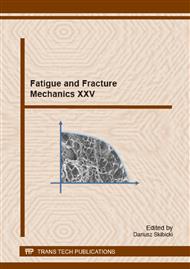[1]
Basquin O. H.: The experimental law of endurance test, Proc. ASTM, Philadelphia 1910, Vol. 10, pp.625-630.
Google Scholar
[2]
Morris J. W. JR.: The Influence of Grain Size on the Mechanical Properties of Steel, Lawrence Berkeley National Laboratory, Berkeley (2001).
Google Scholar
[3]
Korda A. A. et al.: In situ observation of fatigue crack retardation in banded ferrite-pearlite microstructure due to crack branching. Scripta Materialia 54 (2006), p.1836.
DOI: 10.1016/j.scriptamat.2006.02.025
Google Scholar
[4]
EN 10025-1: 2005 Hot rolled products of structural steels - Part 1: General technical delivery conditions.
DOI: 10.3403/30397781u
Google Scholar
[5]
EN 10028-3: 2005 Flat products made of steels for pressure purposes. Weldable fine grain steels, normalized.
DOI: 10.3403/30187559
Google Scholar
[6]
Elements of Metallurgy and Engineering Alloys, Chapter 14 Fatigue, ASM International, Material Park, Ohio, USA.
Google Scholar
[7]
Dobrzański L.A.: Metalowe materiały inżynierskie. Wydanie I, Wydawnictwa Naukowo-Techniczne. Warszawa (2004).
Google Scholar
[8]
Kurek M., Łagoda T., Katzy D., Comparison of fatigue characteristics of some selected materials, Materials testing (Materialprufung), Vol. 56, no. 2, 2014, pp.92-95.
DOI: 10.3139/120.110529
Google Scholar
[9]
Niesłony A., Kurek A., el Dsoki, C. & Kaufmann, H. A study of compatibility between two classical fatigue curve models based on some selected structural materials. International Journal of Fatigue 39, 88-94 (2012).
DOI: 10.1016/j.ijfatigue.2011.03.002
Google Scholar


